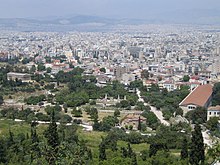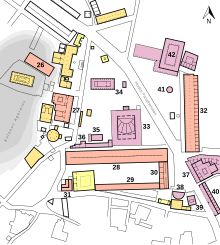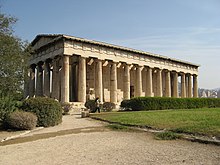Ancient Agora of Athens
Αρχαία Αγορά της Αθήνας | |
 | |
| Alternative name | Classical Agora |
|---|---|
| Location | Greece |
| Region | Attica |
| Coordinates | 37°58′30″N 23°43′21″E / 37.97500°N 23.72250°E |
| History | |
| Material | Marble |
| Founded | 6th century BC |
| Periods | Minister for Culture |
| Public access | Yes |

The ancient Agora of Athens (also called the Classical Agora) is the best-known example of an ancient Greek agora, located to the northwest of the Acropolis and bounded on the south by the hill of the Areopagus and on the west by the hill known as the Agoraios Kolonos, also called Market Hill.[1] The Agora's initial use was for a commercial, assembly, or residential gathering place.[2]
Buildings and structures of the classical agora


North side of the agora
- Stoa Poikile (Painted stoa), a building built in the 5th century B.C. used purely for socialising unlike many other buildings in the agora.[3]
- Altar of the Twelve Gods
- Stoa Basileios (Royal stoa)
- Temple of Aphrodite Urania
- The south end of what is believed to be a Basilica has been uncovered near Hadrian Street and is dated to the mid 100s C.E.[4]
East side of the agora
- The Stoa of Attalos, a stoa lined with shops built in the 2nd century B.C. which has since been reconstructed for use as the Museum of The Ancient Agora.[5]
- The Square Peristyle was a law court originally located under the northern end of the Stoa of Attalos.
- A collection of buildings were added to the south-east corner: the East stoa, the Library of Pantainos, the Nymphaeumand a temple.
- The Library of Pantainos was more than just a library, the west and north wings were series of rooms that were used for other purposes other than storing books. With the construction of the Library of Pantainos, the official entrance into the agora was now between the Library and the Stoa of Attalos.[6]
- The Mint, a building which was used for the minting of bronze coinage in the 2nd and 3rd centuries B.C. but there is no evidence for it being used for the minting of Athenian silver coinage.[7]
- The Monopteros was located south of the Basilica and also dated to the mid 100s C.E. It had no walls, was a dome supported by columns and was about 8 meters in diameter.[8]
- The Bema was a speakers platform and was located near the Stoa of Attalos.[9]
South side of the agora
- The Middle stoa which was the most extensive monument built during the 2nd century B.C.[10]
- The Southwest Temple, built with material from Thorikos in the early first century AD.
- South-east Fountain House
- South Stoa I
- Aiakeion
West side of the agora
- Strategeion
- Agoraios Kolonos
- Tholos
- Boundary stone
- Monument of the Eponymous Heroes, a monument for the ten heroes of the tribes of Athens which was also used as a notice board for new legislation, public events and military conscription.[11]
- Metroon (Old Bouleuterion)
- Bouleuterion
- Temple of Hephaestus (Hephaestion)
- Temple of Apollo Patroos
- Stoa of Zeus
- The Temple of Zeus Phratrios and Athena Phratria dated to the 300s B.C. and is located near the Temple of Apollo Patroos.[12]
- A statue of the Roman emperor Hadrian was located near the metroon.[13]
Other notable monuments

A number of other notable monuments were added to the agora. Some of these included:
- An Altar of Zeus Agoraios was added just to the east of the Monument to the Eponymous Heroes.[14]
- The Temple of Ares, dedicated to Ares, the god of war, was added in the north half agora, just south of the Altar of the Twelve Gods.[15]
- The Odeon of Agrippa and accompanying gymnasium were added in the centre of the agora.[16]
- There is evidence of a Synagogue in the Agora of Athens in the 3rd century.
Gender roles in the Athenian Agora
Professions
In the 4th and 5th centuries, there was significant evidence of women being innkeepers and merchants selling their products in the market of the Athenian agora. Some of the products they sold included fruits, clothes,
Rituals
The
Marble-workers in the Athenian Agora
As of the early 5th century, the Ancient Agora of Athens was known as glorious and richly decorated, set with famous works of art, many of them sculpted from marble. The buildings of the Athenian Agora had marble decoration and housed dedications in the form of marble statues. Finds from the agora excavations identified that generations of marble-workers made the agora of Athens an important center for the production of marble sculptures. Marble-workers made sculptures, marble weights, sundials, furniture parts, and an assortment of kitchen utensils. Excavations of the Athenian agora revealed the remains of many marble-working establishments, various unfinished statues, reliefs, and utilitarian objects.
Marble workshops in the Agora
Excavations of the Athenian agora have proved that marble-workers were very active, the earliest workshops being established in the early 5th century. The earliest areas used by marble workers was the residential and industrial district southwest of the agora. Another area where marble-workers set up shop was in the South Square, after the sack of Athens by the Roman general Sulla in 86 BC. As the South Square was in ruins, marble-workers were attracted to the remains of the marble temples. A workshop from the southern corner of the agora was also important, the Library of Pantainos rented out rooms to marble-workers.
Famous marble-workers in the Agora
Literacy and evidence from excavations give a sense of statues and famous marble sculptors in the Athenian agora. These famous marble-workers of the Agora include, the 5th-century master Phidias and his associate Alkamenes, and the 4th-century sculptors Praxiteles, Bryaxis, and Euphranor.
Phidias
Phidias was the most well known marble-worker to have worked in the agora. He was famous for his gold and ivory cult statue of Zeus at Olympia, and for his three lost sculptures of Athena.
Alcamenes

A well-known associate of Phidias was Alcamenes, whose most important works in the agora were the bronze cult statues of Hephaestus and Athena in the Temple of Hephaestus.
Praxiteles and Bryaxis
These famous sculptors are attested in the agora by the discovery of signed pieces of work that could no longer be preserved. A marble statue signed and possibly carved by Bryaxis was found in the agora behind the Royal Stoa.
Euphranor
The 4th century marble-worker known for his sculptures, made a colossal statue of Apollo for the Temple of Apollo Patroos on the west side of the agora.[18]
Excavations
The ancient Athenian agora has been excavated by the American School of Classical Studies at Athens (ASCSA) since 1931 under the direction of Thomas Leslie Shear, Sr.[19] His wife Josephine Platner Shear who supervised the digging and led the study and conservation of numismatics from the site, as well as making the discovery of a new 2nd-century C.E. Athenian coin.[20][21] The excavation was negotiated and directed by the ASCSA's chair of the agora excavation committee, Edward Capps, whom the school would honor with a memorial overlooking the project.[22][23][24] John McK Camp served as Director of the excavations since 1994, until his retirement in 2022. John K. Papadopoulos is now in the position of Director following Camp's retirement.
After the initial phase of excavation, in the 1950s the Hellenistic Stoa of Attalos was reconstructed on the east side of the agora, and today it serves as a museum and as storage and office space for the excavation team.[25]
A virtual reconstruction of the Ancient Agora of Athens has been produced through a collaboration of the American School of Classical Studies at Athens and the Foundation of the Hellenic World, which had various output (3d video, VR real-time dom performance, and Google Earth 3d models).[26]
Flora
Evidence of planting was discovered during the excavations and on 4 January 1954, the first
Museum of the Ancient Agora
The museum is housed in the Stoa of Attalos, and its exhibits are connected with the Athenian democracy. The collection of the museum includes clay, bronze and glass objects, sculptures, coins and inscriptions from the 7th to the 5th century B.C., as well as pottery of the Byzantine period and the Turkish occupation. The exhibition within the museum contains work of art which describes the private and public life in ancient Athens. In 2012, new sculpture exhibition was added to the museum which includes portraits from Athenian Agora excavation. The new exhibition revolves around portraits of idealized gods, officially honored people of the city, wealthy Roman citizens of the 1st and 2nd century A.D., 3rd-century citizens and finally on work of art from private art schools of late antiquity.[28]
 Media related to Museum of the Ancient Agora at Wikimedia Commons
Media related to Museum of the Ancient Agora at Wikimedia Commons
See also
- Ecclesia
- Church of the Holy Apostles
References
- ^ R. E. Wycherley, Literary and Epigraphical Testimonia (Athenian Agora) (American School of Classical Studies, 1957), p. 27.
- ^ Sakoulas, Thomas. "The Agora of Athens". ancient-greece.org. Retrieved 4 November 2017.
- ^ "Agora Monument Stoa Poikile – ASCSA.net". agora.ascsa.net. Retrieved 28 November 2021.
- ^ Camp, The Athenian Agora: Site Guide, p. 93.
- ^ Camp, The Athenian Agora: Site Guide, p. 123.
- )
- ^ "Agora Monument Mint – ASCSA.net". agora.ascsa.net. Retrieved 28 November 2021.
- ^ Camp, The Athenian Agora: Site Guide, p. 118.
- ^ Camp, The Athenian Agora: Site Guide, p. 122.
- ^ Camp, The Athenian Agora: Site Guide, p. 168.
- ^ "Agora Monument Eponymous Heroes – ASCSA.net". agora.ascsa.net. Retrieved 28 November 2021.
- ^ Camp, The Athenian Agora: Site Guide, p. 73.
- ^ Camp, The Athenian Agora: Site Guide, p. 63.
- ^ Camp, The Athenian Agora: Site Guide, p. 65.
- ^ Camp, The Athenian Agora: Site Guide, p. 110.
- ^ Camp, The Athenian Agora: Site Guide, p. 114.
- )
- OCLC 61478156.
- ^ "The American School of Classical Studies at Athens". www.ascsa.edu.gr. Archived from the original on 16 June 2006. Retrieved 13 January 2022.
- ^ Armstrong *14, April C. (6 November 2019). "Faculty Wives and the Push for Coeducation at Princeton University". Mudd Manuscript Library Blog. Retrieved 26 August 2021.
{{cite web}}: CS1 maint: numeric names: authors list (link) - S2CID 164451358.
- ^ "About Edward Capps | American School of Classical Studies at Athens". www.ascsa.edu.gr. 19 July 2011. Retrieved 6 May 2021.
- S2CID 164414874.
- ISSN 0362-4331. Retrieved 6 May 2021.
- ^ "Overview: The Archaeological Site".
- ^ Sideris, Athanasios. "A Virtual Cradle for Democracy: Reconstructing the Ancient Agora of Athens".
{{cite journal}}: Cite journal requires|journal=(help) - ^ Garden Lore of Ancient Athens. American School of Classical Studies. p. 4.
- ^ "Ministry of Culture and Sports | Museum of the Ancient Agora". odysseus.culture.gr. Retrieved 29 September 2017.
Further reading
- Camp, J. (2010). The Athenian Agora Site Guide. 5th ed. Princeton, New Jersey: American School of Classical Studies. ISBN 978-0-87661-657-4
- Dickenson, Christopher P. (2015). "Pausanias and the "Archaic Agora" at Athens." Hesperia: The Journal of the American School of Classical Studies at Athens 84.4: 723–770.
- Dickenson, Christopher P. and Onno M. van Nijf ed. (2013). Public Space in the Post-Classical City: Proceedings of a One Day Colloquium held at Fransum, 23rd July 2007. Caeculus, 7. Leuven: Peeters.
- Gawlinski, L. (2007). "The Athenian Calendar of Sacrifices: A New Fragment from the Athenian Agora." Hesperia 76:37–55.
- Harris, Edward Monroe (2014). "Wife, Household, and Marketplace." In Women Who Count in Greek History. Edited by Umberto Bultrighini, Elisabetta Dimauro. Lanciano: Carabba.
- OL 23845464M
- Lang, M. (2004). The Athenian Citizen: Democracy in the Athenian Agora. Rev. ed. Agora Picturebook 4. Princeton, New Jersey: American School of Classical Studies at Athens. ISBN 9780876616420(John McK. Camp's revision of 1987 1st edition)
- MacKinnon, Michael (2014). "Animals, Economics, and Culture in the Athenian Agora: Comparative Zooarchaeological Investigations." Hesperia: The Journal of the American School of Classical Studies at Athens 83.2: 189–255.
- ISBN 978-0-87661-635-2.
- Wycherley, R. E. (1973). The Athenian Agora. Vol. 3, Literary and Epigraphical Testimonia. Princeton, New Jersey: American School of Classical Studies.
External links
- Hellenic Ministry of Culture: The Ancient Agora of Athens – official site with a schedule of its opening hours, tickets and contact information.
- Agora Excavations – American School of Classical Studies Agora excavation project.
- Map of the Agora of Athens in Socrates and Plato's time
- Agora of Athens in 421 BC
- The Athenian Agora: A Short Guide in Color
- The Athenian Agora. A Guide to the Excavation and Museum
- Reconstruction of the Athenian Agora in Google Earth
- Ministry of Culture: The Museum
- www.athensinfoguide.com The Museum
- Agora of Athens photos


